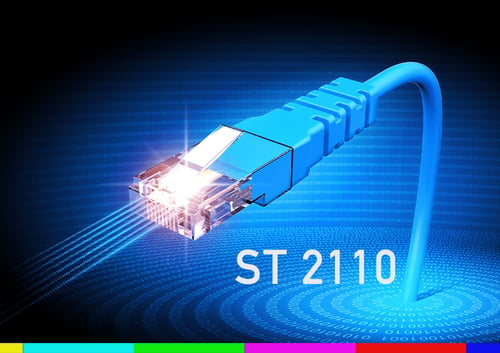SMPTE 2110 FAQs
What is the SMPTE ST 2110 Suite of Standards?
The 2025 Emmy® Award-winning SMPTE ST 2110 Professional Media Over Managed IP Networks suite of standards is a major contributing factor in the movement toward one common internet protocol (IP)-based mechanism for the professional media industries.* The foundation for SMPTE ST 2110 standards is Video Services Forum (VSF) Technical Recommendation for Transport of Uncompressed Elementary Stream Media Over IP (TR-03), which VFS agreed to make available to SMPTE as a contribution toward the new suite of standards. The SMPTE ST 2110 standards suite specifies the carriage, synchronization, and description of separate elementary essence streams over IP for real-time production, playout, and other professional media applications.
What is the status of ST 2110?
The SMPTE ST 2110 standards suite is multipart and is continually in active development to support additional features since its release in 2017 – 2019.
What does the adoption of the SMPTE ST 2110 suite of standards mean for the industry?
The impact goes beyond replacing serial digital interface (SDI) with IP to having the flexibility to implement an entire new set of applications based on, and leveraged off, information technology (IT) protocols and infrastructure.
The advantages of shifting to IP are comparable to those achieved when the industry transitioned from physical tapes to virtual files for content storage. Files were not treated as if they were just virtual tapes; rather, all the benefits of software and virtualized access have come to be realized with new workflows and functionality.
Another key advantage is that intra-facility traffic now can be all IP. Rather than requiring two separate sets of switches — SDI switches for professional media and IP/Ethernet switches for general data — facilities can rely on one common data center infrastructure. Most operators will continue to separate traffic by priority; however, the newer switches do have the intelligence to prioritize real-time media streams.
Are there products on the market that support SMPTE ST 2110 standards?
Yes. The SMPTE ST 2110 Drafting Group includes representatives from many different manufacturers and SMPE ST 2110 products are widely available. At the IBC and NAB Show, many of those vendors regularly participate in IP showcases and demonstrate SMPTE ST 2110 standards interoperability and solutions based on the suite.
ST 2110 is not only a SMPTE standard — it has been embraced as an industry standard. SMPTE ST 2110 is continually updated and components are added in step with the evolution of new technologies.
What is unique about how the ST 2110 standards suite handles ancillary data?
ST 2110 standards make it possible to separately route and break away ancillary data, as well as the audio and video. This change promises to simplify the process of adding metadata such as captions, subtitles, Teletext, and time codes, as well as tasks such as the processing of multiple audio languages and types.
All elements can be routed separately and brought together again at the endpoint. With ST 2110 standards, each component flow — audio, video, metadata —is synchronized to each other while remaining independent streams
How about Ultra HD, including 4K, 8K, and high-dynamic-range (HDR) imaging? Do SMPTE ST 2110 standards account for new and emerging formats?
Yes! SMPTE ST 2110 standards are video-format-agnostic and therefore support Ultra HD, HDR, and other new and emerging formats.
Are there accessibility features in SMPTE ST 2110?
Yes, SMPTE ST 2110 supports the inclusion of closed captioning and subtitles. This can either be achieved by using the traditional VANC carriage or through one of the profiles of TTML2 defined in W3C IMSC1.2 for online applications.





 Education, Membership and Standards Directors
Education, Membership and Standards Directors
 Fellows
Fellows
 Award Programs
Award Programs
 Society Governance
Society Governance







 Section Officers and Managers
Section Officers and Managers
 Section Event Non-Member Sign-Up
Section Event Non-Member Sign-Up










 Standards Projects
Standards Projects
 Registration Authority
Registration Authority
 SMPTE GitHub
SMPTE GitHub
 Patent Statements
Patent Statements
 Advisory Notes
Advisory Notes
 Appeals
Appeals
 Work with SMPTE
Work with SMPTE




 Editorial Calendar
Editorial Calendar
 Guidelines for Submitting
Guidelines for Submitting
 Subscribe
Subscribe
 Board of Editors
Board of Editors






 Media Kit
Media Kit
 SMPTE Logos
SMPTE Logos
 Support Request
Support Request
 Get Alerts!
Get Alerts!
 SMPTE Stories
SMPTE Stories




















